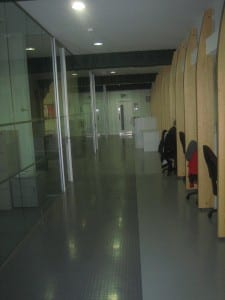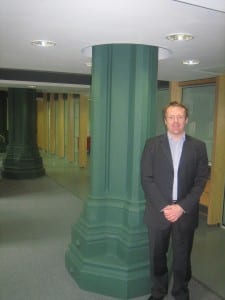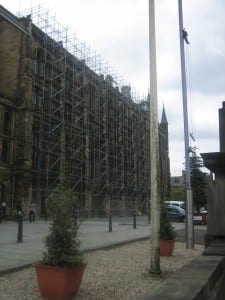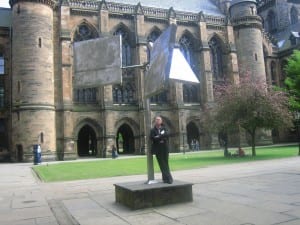University of Glasgow: Post Graduate Centre
Innovation

Interior
The focus of the case study at the University of Glasgow is the new Post Graduate Centre (PGC). The PGC centre is a refurbished space designed specifically for the university’s postgraduate students, and is located in a Grade A historic building in the heart of the University’s Gilmorehill campus. The space combines the historical features of the building, including the original stonework and greek pillars, with more modern features, such as glass panelled offices. The space is comprised of a number of research offices for PhD students, a core area which students can use as meeting rooms, and a number of social learning areas for students to work collaboratively on projects or to sit and have a coffee. The space has Wi-Fi access so that students can use laptops and handheld technology.
The idea for the space was to provide postgraduate research and postgraduate taught students with a place where they could work and meet as previously they were dispersed all over the university campus. The space is part of a request from academics and students to develop the quality of teaching space as well as to provide more social learning spaces at the university as the previous provisions were regarded as being ‘very poor’.
The space is well used by postgraduate research students, especially PhD students, but appears to be underused by the postgraduate taught students. One of the reasons identified by members of staff at the university was that the space is not supported by a service model to assist students who want to work in the space: ‘I think this is where we fundamentally fell down as there is no managerial or operational support. The user group just thought the building was going to manage and operate itself’ (Project Manager).
While some thought was given to the fact that the space could be supported by the main library staff, no provision was made in terms of having a reception desk for the Centre or for a more structured system for student support. Members of staff also indicated that the actual location of the space may not be appropriate for postgraduate students as it is located a considerable distance from their accommodation facilities: ‘It is possible that none of the postgraduates actually venture up the hill and they haven’t really got a need to be in the area of the PGC’ (Estates).
Mission and Vision

Estates Manager, Jim McConnell
The university has a long historical tradition, dating back to 1451, making it the one of the oldest universities in the UK. As such the university has a number of old listed buildings, which serve as an important selling point for the university. However, the historical significance of the building causes problems in terms of the development of new space, and any ideas for new developments have to go through ‘Historic Scotland’ for planning permission. The university is an important part of the city, and a number of its iconic buildings, are part of the ‘Glasgow with Style’ marketing campaign for regional development.
The university is a research intensive institution, and, as such, research has been the main focus of space planning. This focus has started to change recently: ‘traditionally there has been more of a focus on developing research space and facilities, and it is only in the past two years that there has been an interest in the development of teaching and learning space’ (Estates).
The university is starting to think about the kind of learning spaces that it wants to develop, and there is an academic drive to develop space that will support an enquiry-based approach to teaching and learning. However, this is still proving difficult to achieve ‘there is always a battle because of the research history of the university, but I do want to see the need for social space and informal learning space for students addressed’ (Senior Academic).
Leadership and Governance

Under construction
In terms of its organisational structure, the university has a ‘devolved’ form of leadership, which is driven by the faculties. As such, the faculties have a strong role in the university’s decision making process. To support this, the deans of faculty are given a budget and have discretionary authority over limited amounts of money, which allows small scale projects to develop independently of the main university decision making process. On a small scale this supports innovation in space design, but has also led to a lack of central corporate direction, and arrested academic ability to work collaboratively across faculties and departments ‘for such a long time we were in silos in different faculties, and for years we have been trying to get people to work together’ (Estates).
The university has addressed this issue by creating ‘faculty management teams’ for each faculty, where each head of department in the faculty is on the relevant faculty team. This allows for a greater dialogue between heads of departments, but also between different faculties and departments. The ‘faculty management teams’ also report to senior management in order to align the faculties and departments with the core organisational structure of the university. There is also a role in this process for the deans to act as a ‘conduit’ for information and to give the departmental perspective to the faculties and the central university management. As a result there is a general feeling that the university is starting to become much more strategic in its decision making ‘I think there has been a real transformation in the last five years. I have been involved much more centrally, and it seems to me that we are much more strategy orientated then we have been in the past’ (Senior Academic).
One of the problems that the university has in terms of leadership in space planning is the relationship between academics and estates ‘Estates and academics are not fully aligned in their expectations’ (Senior Academic). As a result of this, there is an interesting debate about who should have responsibility for space design at the university. Much of this can be put down to a view within the university that academics, in the main, appear to struggle with articulating the kind of teaching and learning space that they want to support their activities:
‘Academics may know what they want to do but might not know what is possible… it needs someone to show us what innovative teaching spaces might look like. Estates are best placed to show academics what to do. We want spaces to work well for learning, but we do not always know how to achieve this’ (Senior Academic).
One of the problems is that estates are not usually well versed in pedagogical developments, and thus there is a lack of alignment between what academics want and what estates can provide; and, indeed, who should be leading this process. There is a strong feeling that academics and estates are quite often working in two different paradigms and not speaking the same language ‘The interface between academics and estates is not so great and the two groups have different sets of expectations… academics speak the language of activity and we speak the language of space’ (Senior Academics). A view within the university is that there is little understanding by estates of the processes involved in teaching and learning and quite often this has led to frustration from academics engaged in space planning: ‘I was banging my head on a brick wall for a couple of years as it was never clear to me how money for space was allocated’ (Senior Academic).
In response to this, senior academics have created the ‘Learning Space Group’ to discuss teaching and learning and space planning ‘we set this group up to address issues about teaching and learning space that were of concern to us’ (Senior Academic). This group, which consists of academics and is chaired by estates, attempts to connect the development of teaching and learning space with the teaching and learning strategy. The estates department is also embedded into the university’s strategic planning and reports annually to the Research Strategy and Planning Committee, Teaching and Learning Committee, Senior Management Group and University Court. The estates department have also gone a step further, and are now attempting to make itself more aware of pedagogical developments ‘Estates has traditionally responded by providing a service model, but we should be able to offer a lot more. We need to up our game and get involved in understanding the teaching and learning experience’ (Estates).
To support this, the university has been conducting surveys of its teaching and learning spaces. These surveys are conducted by an external consultant and have enabled the university to gather core knowledge and understanding of its space ‘this has enabled us to develop survey models, which in turn allow us to experiment with some of our lecture space’ (Estates).
The result of this has been to consider ways of making lecture theatres more flexible by being able to facilitate group work and interaction through the provision of moveable seating. However, the estates department wants to go much further than this and actually do the research themselves: ‘We need to do a bit of recognisance and reflect on that, and not just on what the external designers tell us so that we can get a knowledge of what it is like to be taught at Glasgow’ (Estates).
The university also actively engages its students through the Student Representative Council (SRC). The SRC plays an engaged role in space planning and the development of projects. As part of this, students sit on most of the university’s committees, including teaching and learning, estates, and senior management groups. However, one thing that students do not complain about is space ‘students complain about books and other things, but I seldom hear them complain about space (Senior Academic)’.
Developing the Brief

Scultpure
The driver for the Postgraduate Centre originated from the Faculty of Law, Business and Social Sciences, which had seen an increase in domestic and international postgraduate students.
Ultimately, it was decided that the university would build a Post Graduate Centre, which should be shared by three different faculties: the faculty of Law, Business and Social Sciences, the faculty of Arts and the faculty of Education. The problem with involving all three faculties in the project was that: ‘each of the faculties had different views about what they wanted and they all wanted different things, and that was the problem, so we had to come away with a compromise’ (Client Group Member). The result was to try and coordinate three faculties with very different agendas, which created problems for the development of the space ‘I think this is what got us in a mess. The result is that we are left with a very beautiful space which is not utilised because it was not what we needed in the first place’ (Client Group Member).
In addition, there was also poor alignment between academics and estates on the briefing process. From the estates side: ‘the academics who were involved did not know about the estates processes, they just did not understand what we expected from them and what they expected from us …and they did not organise the things that they thought we would be organising, so things fell through the cracks’ (Project Manager).
In hindsight the client group commented that they wished there was a more established process to help them with the development of the project ‘it would have been useful if we had some kind of guidelines that we could have all agreed on at the start, so that it was clear what was the responsibility of estates and what was the responsibility of the faculties and departments’ (Client Group Member).
From some of the academics: ‘I did not know what I was doing and I probably made a load of mistakes in terms of the hand over. I never fully appreciated the interface between the user group and estates. Lines of communication broke down and I should have put structures in place to keep them going’ (Client Group Member).
The university has realised that some of these problems could have been avoided if there had been a greater involvement from the students ‘we did not involve students early enough in the process before it went out to architect’s (Client Group Member).
Project management
The university has learned from this and as a result has adopted a formal approach to project management, which is based on PRINCE 2 methodology and has standardised forms for delivering projects.
Post-Project Evaluation
The PGC underwent a formal post occupancy evaluation six months after the space was handed over to the faculties which uncovered most of the problems noted above. Amongst the minor problems found were the lack of Wi-Fi access and problems with swipe card access for students. There were also problems with access to drinking water and the lack of any kitchen facilities for the students. More significantly, the post occupancy evaluation highlighted that there was a lack of communication between the three faculties involved in the development of the space, and that their expectations for that space were ‘unrealistic’. In addition to uncovering these problems the students felt that there were limits with this type of evaluation as most of the questions were irrelevant from their perspective.
Leave a Reply